As I walked from the camping area at the Bridge of Orchy to the hotel for breakfast (but mostly to charge my phone during breakfast), I passed a stream of people with day packs just off the train, heading for the West Highland Way.
I envied them. For me, this was going to be another day on single-file paths or no paths at all, climbing 2,222 feet, according to the route estimate.
I crossed the railroad tracks and headed in a direction none of the West Highlanders were going—up through a slot in the hills called Coire an Dothaidh.
This is looking up to it.

Nearly at the top, I looked back. The few white buildings next to the road is where I started. It takes balls to leave Bridge of Orchy by this route.
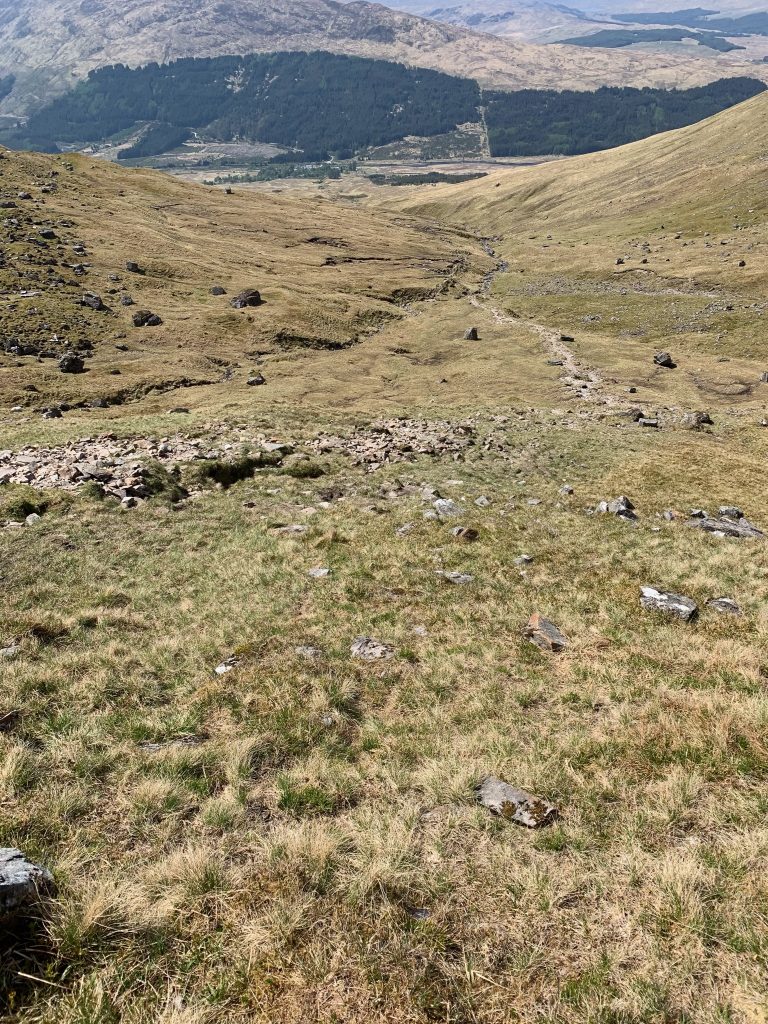
I was willing to do so for one reason. I wanted to see Tigh nam Bodach. It is reputed to be the only surviving shrine to Cailliche (alternatively Cailleach), one of the creation deities of Celtic folklore, in Britain. It is also said to be the site of the oldest uninterrupted pagan ritual in the United Kingdom.
I’d heard about it from Jean Macrae Turner after one of my previous crossings. She’s gone past it on two of her many Challenges, and my route this year is based on one of those previous routes.
But first I had to get there.
It was another sunny day. The landforms in this part of Scotland are simple, the palette limited, the effect beautiful.
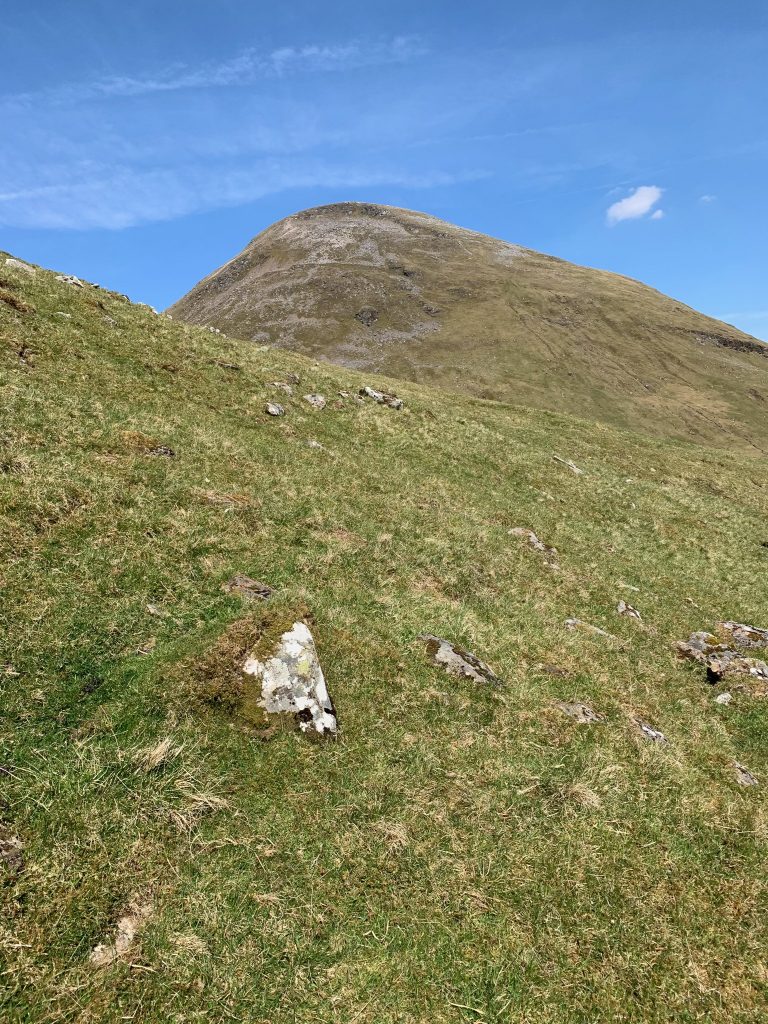
When I went through the aforementioned col, or coire in Gaelic, I could see the next couple of hours of work ahead of me. My route was to the bottom of the glen, and then to turn left and go up Gleann Cailliche, which is now commonly translated from Gaelic as the Glen of the Old Woman.

It’s believed that 200 to 300 people used to live at least part of the year in this glen. They were both pastoralists and farmers. Many would leave their winter lodgings in the village at the bottom of the glen and spend the summer in “shielings”—primitive stone summer houses—up the glen.
They took their animals with them—cattle, not sheep. (The latter were brought in to replace the people in the Highland Clearances of the 18th and early 19th centuries.) The cattle would get the benefit of lush grasses in the high meadows, and the oat and barley fields down the glen would be freed of bovine depredation.
You can see the remains of some of this activity in the glens. I walked by this structure, which was probably a sheepfold, not a cattle corral, from a later era.
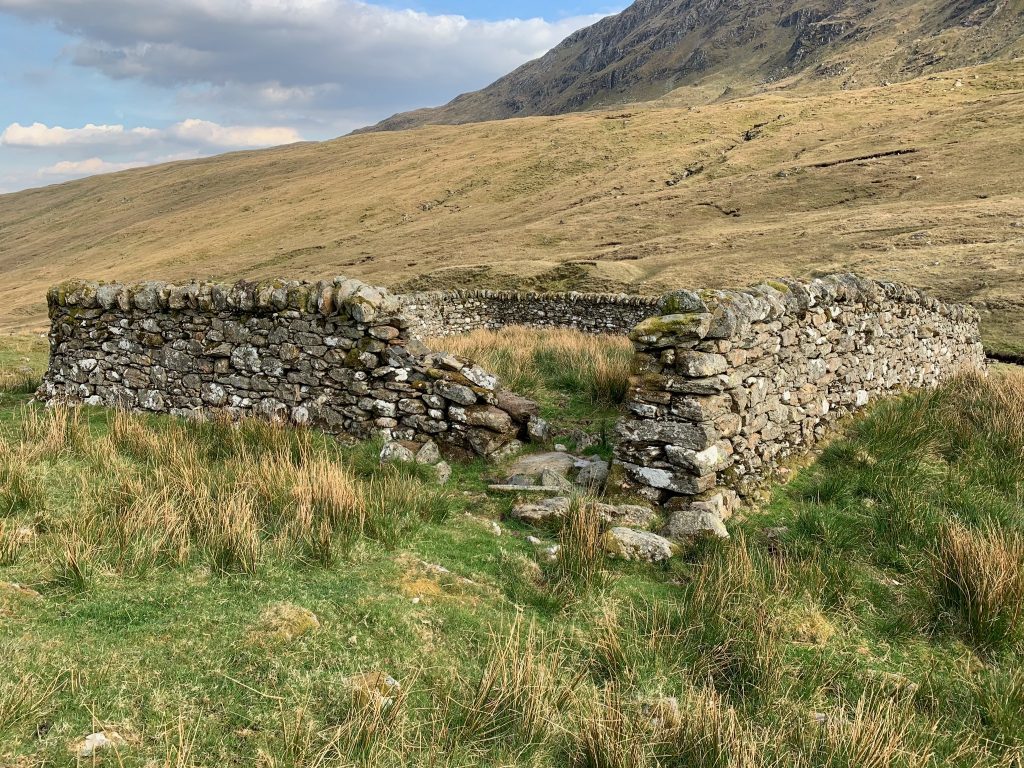
Shielings are now little more than piles of stones slowly being buried by grass and moss. They will eventually be covered by peat, the great eraser and preserver of Scottish material history.
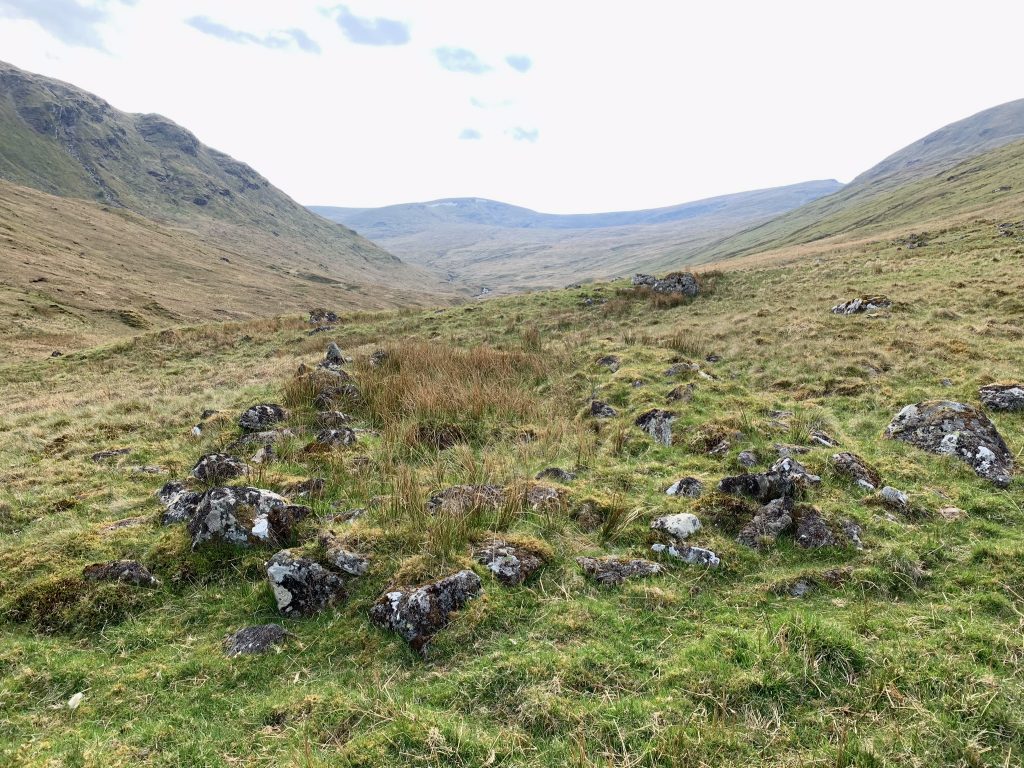
I walked a long time.
After getting to the bottom of the valley and turning to the left, I stopped for my mid-afternoon appointment of podiatric hydrotherapy in Allt Cailliche, the stream of the Old Woman.

I got to Tigh nam Bodach in late afternoon, which was plenty early in a place that doesn’t get dark, a month before the summer solstice, until after 9 o’clock.
The shrine is a miniature shieling. It originally had a thatched roof; now it has a turfed one. Outside it are seven water-sculpted stones with humanoid, Henry Moore-like forms. A larger, and no doubt more recently added, family of stones is on either side of the structure.
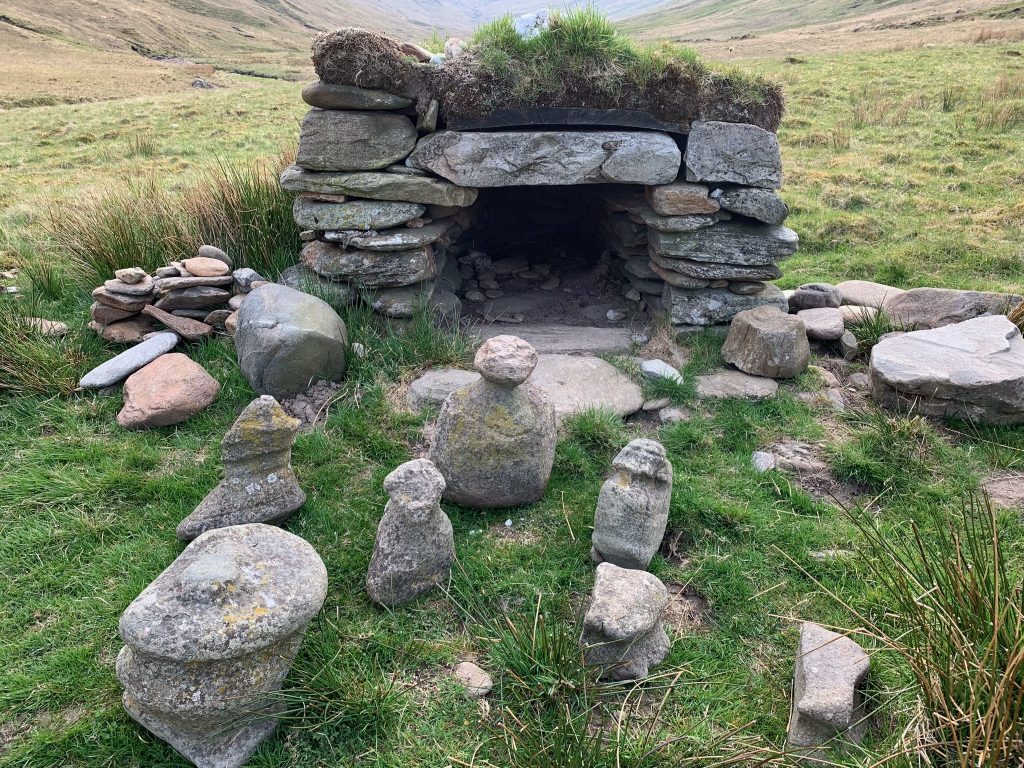
There is a variety of stories about the creation of this structure. One is that the goddess Cailliche came to the glen when she was pregnant. She sought shelter, and was given it by people in the glen. She blessed them and they built a shrine to her. In one telling, she gives birth to another child every hundred years, which would explain the proliferation of stones.
Whatever the origin, for centuries local people have tended to the shrine and the Old Woman’s needs.
In the days of seasonal occupation of the high glen, an early party each year would re-thatch the shrine’s roof around the first of May, a holiday known as Beltane. They’d also move the family of stones out of the miniature shieling where they’d spent the winter. This was done before people repaired their own shielings from the winter’s wear.
At the end of October, at the holiday of Samhain just before the pastoralists returned to the foot of the glen, they would move the family inside, seal up the front, and chink every crack with moss against the winter weather.
Some version of this is still done now. Who exactly does it isn’t widely known. It’s a bit like the bottle of brandy that appears at Edgar Allan Poe’s grave in Baltimore on his birthday each year. It just happens.
This is the stone that is believed to represent the Old Woman, the goddess Cailliche.
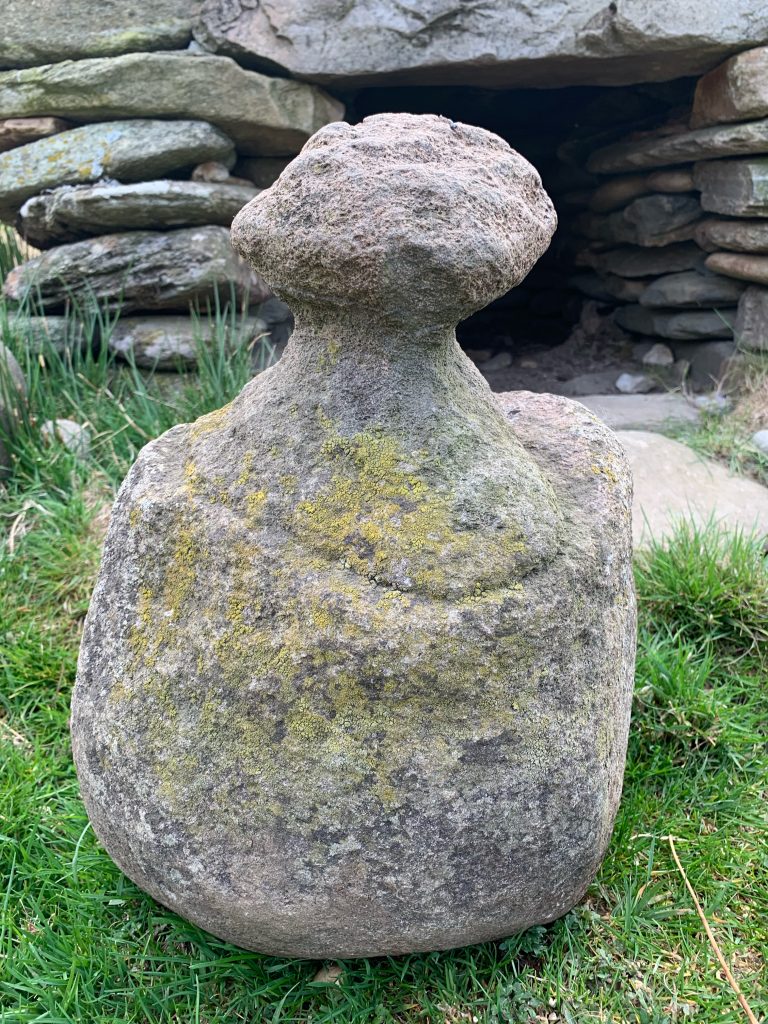
Within the last decade, the shieling part of the shrine was rebuilt. This appears to have been a guerilla operation. I suspect with enough time and effort the self-appointed rehab architect could be found. But I have walking to do.
Here is a picture of Tigh nam Bodach in the mid-1960s, from the book “Highland Perthshire” (1969) by Duncan Fraser.

Fraser wrote: “There is no doubt that the Cailliche has been there a long time—so long that even four centuries ago, when first we hear of this glen, it already bore her name. And probably it goes back to pre-Christian times, to the days of the circular forts or even further to the Bronze Age people.”
I stayed a while at the shrine. Before I left, I looked at the hill to the north and saw some sheep walking along a terrace in the steep slope. They were the only visible movement anywhere in sight.

I walked two more miles, stopping a mile before my intended destination when I found a camping spot by the stream that was too good to pass up. Plus, I wanted to spend a night in the Old Woman’s glen, although at a respectful distance.
I pitched the tent and watched the sun fall, bruising the sky.

There wasn’t a human being within sight or hearing.
Your description of the elevation change, combined with the photo of the shieling’s straight walls and apparent 90 degree corners made me wonder about the long-ago uphill labor of stone gathering and carriage. It could not have been casual, quick work.